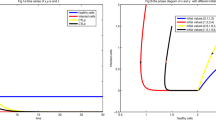Abstract
Our previous study proposed an immune network model with evolving dynamics for antigen-specificity of a lymphocyte receptor, and obtained the following results: 1) the model revealed threshold dynamics to determine an immunological self/non-self boundary, and furthermore 2) the application of the threshold dynamics enabled an immune memory function. However, as the model equations were high- dimensional and nonlinear, the study could not explicate a mechanism for these immunological phenomena by analyzing the model equations. This study proposes a “minimal and analyzable” model that enables the reproduction of these two immunological phenomena. From analyses of isoclines of the model equations, 1) the threshold dynamics stems from the so-called excitable dynamics that are well-known in the firing dynamics of the neuron, and 2) the immune memory is realized not as a stable dynamical attractor, but as a long-lasting transient. This result indicates the possibility of a new type of immune memory different from the known dynamic attractor immune memory.
Preview
Unable to display preview. Download preview PDF.
Similar content being viewed by others
References
Jerne, N.K.: Ann. Immunol. 125C, 373–389 (1974)
Varela, F.J., Andersson, A., Dietrich, G., Holmberg, A., Kazatchkine, D., Coutinho, A.: Proc. Natl. Acad. Sci. U. S.A. 88, 5917–5921 (1991)
Harada, K., Ikegami, T.: ECAL 1999. LNCS, vol. 1674, pp. 427–431. Springer, Heidelberg (1999)
Harada, K., Ikegami, T.: J. Theor. Biol. 203, 439–449 (2000)
Harada, K., Ikegami, T., Shiratori, N.: Proc. of Sixth International Conference on Knowledge-based Intelligent Information Engineering Systems, pp. 728–732. IOS Press, Amsterdam (2002)
Perelson, A.S. (ed.): Theoretical Immunology Parts I, II. Addison-Wesley Pub. Company Inc., New York (1988)
Hayashi, H.: Brain and Chaos. Shokabo, Tokyo (2001)
Author information
Authors and Affiliations
Editor information
Editors and Affiliations
Rights and permissions
Copyright information
© 2003 Springer-Verlag Berlin Heidelberg
About this paper
Cite this paper
Harada, K., Shiratori, N. (2003). Mechanism of a Transient but Long-Lasting Immune Memory Function on a Self/Non-Self Boundary. In: Palade, V., Howlett, R.J., Jain, L. (eds) Knowledge-Based Intelligent Information and Engineering Systems. KES 2003. Lecture Notes in Computer Science(), vol 2774. Springer, Berlin, Heidelberg. https://doi.org/10.1007/978-3-540-45226-3_71
Download citation
DOI: https://doi.org/10.1007/978-3-540-45226-3_71
Publisher Name: Springer, Berlin, Heidelberg
Print ISBN: 978-3-540-40804-8
Online ISBN: 978-3-540-45226-3
eBook Packages: Springer Book Archive




